Create Your Own Art Critique for the Raft of the Medusa
The Raft of the Medusa by Théodore Géricault, currently located at the Louvre Museum, is regarded as a seminal piece of work of French Romanticism. The Raft of Medusa painting portrays a scene that followed later the French naval ship Méduse's wreck, which went aground off the coastline of modern-day Islamic republic of mauritania on the second of July, 1816. Following the incident, at to the lowest degree 147 individuals were abandoned on a hastily made raft; all only xv perished in the 13 days until their retrieval, and those who managed to survive suffered from malnutrition and farthermost dehydration, too every bit cannibalism. The incident created international controversy, in office considering the blame was generally ascribed to the French captain'southward inexperience.
Table of Contents
- 1 The Raft of the Medusa by Théodore Géricault
- one.ane An Introduction to Théodore Géricault
- 2 Analyzing The Raft of Medusa Painting
- 2.1 Contextual Groundwork
- 2.two Description
- two.iii Execution
- three Exhibition and Reception of the Raft of Medusa Painting
- 4 Frequently Asked Questions
- four.ane Which Artist Painted the Raft of the Medusa?
- 4.2 What Was the Raft of Medusa Painting Most?
The Raft of the Medusa by Théodore Géricault
Théodore Géricault opted to correspond this event to embark his career with a large-scale uncommissioned piece on a topic that has already piqued the public's marvel. He was captivated past the occurrence, and before get-go work on the eventual painting, he conducted a considerable study and created several preparatory sketches. He spoke with 2 survivors and built a precise size replica of the raft. He went to hospitals and mortuaries to come across the texture and coloration of the flesh of the bilious and dead in person.
| Year Completed | 1819 |
| Medium | Oil on Canvas |
| Dimensions | 490 cm ten 716 cm |
| Current Location | Louvre Museum, Paris |
An Introduction to Théodore Géricault
Before we become into the artwork itself, y'all may be wondering which artist painted the Raft of the Medusa. Géricault's brief career had a pregnant event on the development of modernistic art, particularly the growth of French 19th-century painting.
His revolutionary use of contemporaneous subjects, his merging of classical aspects with a moody, painterly aesthetic, his dear of equines, his interest in sublime and horrendous topics, and his sympathy for guild's weak and helpless brand him a particularly complicated artist, but one who helped pave the way for Romanticism's focus on sentimentality and subjective experience.
 Portrait of an Artist in His Studio (c. 1820) by Théodore Géricault;Théodore Géricault, Public domain, via Wikimedia Eatables
Portrait of an Artist in His Studio (c. 1820) by Théodore Géricault;Théodore Géricault, Public domain, via Wikimedia Eatables
The Raft of Medusa painting, his nigh renowned piece of work, was a quantum effect in the history of contemporary art since it combined the urgency of the latest bug and a firsthand sensibility with the conventional, massive framework of a major Salon painting.
In its focus on current events and the reality of the man condition, Gericault's work was completely modern.
He drew dramatic events from real life on a grand calibration, and as a draftsman, he found ideas in the most mundane topics. This is evident in his huge Raft of Medusa painting, likewise as his lithographs of London's impoverished and his portraiture of the mentally sick.
 A paralytic adult female being transported along the street in a wheelchair (1821) past Théodore Géricault;Meet folio for author , CC BY iv.0, via Wikimedia Commons
A paralytic adult female being transported along the street in a wheelchair (1821) past Théodore Géricault;Meet folio for author , CC BY iv.0, via Wikimedia Commons
Despite learning from the Old Masters, notably Michelangelo, Géricault's utilize of rapid, dynamic brushstrokes and opposing light effects generated evocative settings that broke loose from the polished Neoclassical school of painting.
Much of Gericault's art exemplifies what we now call Romanticism, with its emphasis on the exotic, emotive, and sublime.
This might be understood as a reaction to David and Ingres' earlier Neoclassicism, which represented Enlightenment ideas of structure and logic. The particular artist's personal, emotional reaction is what matters for Gericault, an idea that would continue through into the 20th century.
Analyzing The Raft of Medusa Painting
The Raft of Medusa painting portrays a scene that followed after the French naval send Méduse's wreck, which went ashore off the coastline of modern-solar day Mauritania on the 2nd of July, 1816. Only there is more than to this story. Permit us now await at a deeper analysis of this painting.
 The Raft of the Medusa (1819) by Théodore Géricault;Théodore Géricault, Public domain, via Wikimedia Commons
The Raft of the Medusa (1819) by Théodore Géricault;Théodore Géricault, Public domain, via Wikimedia Commons
Contextual Background
The French galley Méduse set sheet from Rochefort in June 1816, heading for the port of Saint-Louis in Senegal. She led a company that included the Loire (a Storeship), the Argus (a brig), and the Écho (a corvette). While having barely sailed in 20 years, Viscount Hugues Duroy de Chaumereys had been named commander of the ship.
Following the disaster, popular outcry incorrectly assigned arraign for his employment to Louis Xviii, despite the fact that information technology was a standard naval post fabricated inside the Ministry of the Navy and much outside the monarch'south interests.
The purpose of the ship was to acknowledge the British give up of Senegal as role of France's approving of the Treaty of Paris. Colonel Julien-Désiré Schmaltz, the newly elected governor of Senegal, and his married woman and family unit were counted among the passengers aboard the ill-fated ship.
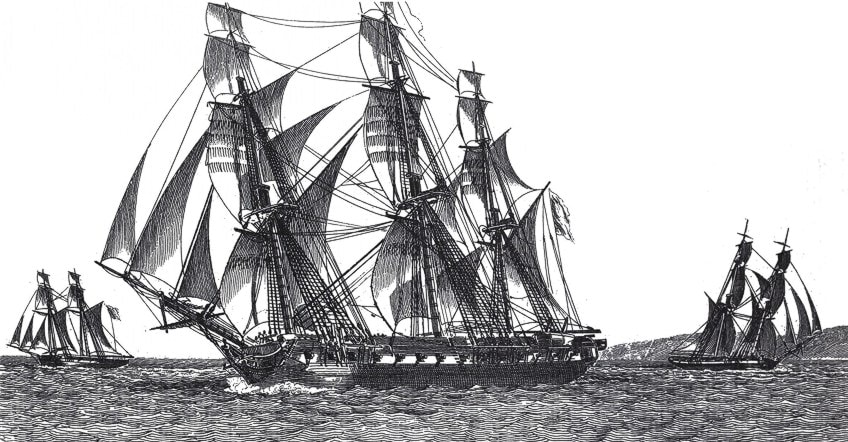 The frigate Méduse sailing various courses shut-hauled in 1816 by Jean-Jérôme Baugean;Jean-Jérôme Baugean, Public domain, via Wikimedia Commons
The frigate Méduse sailing various courses shut-hauled in 1816 by Jean-Jérôme Baugean;Jean-Jérôme Baugean, Public domain, via Wikimedia Commons
The Méduse surpassed the other ships in an attempt to make up time, merely due to inadequate navigation, it wandered 160 kilometers off track. The send ended upwards going aground on a sandbank off the West African coast, on the 2nd of July. The crash was mostly blamed on De Chaumereys' ineptitude, a returning émigré who clearly lacked the necessary experience and skill but had been awarded his appointment as a consequence of political favoritism.
After attempts to liberate the send proved unsuccessful, the terrified crew and passengers embarked on a 100-kilometer journey to the African shore in the frigate'south 6 pocket-sized vessels on July v.
Despite the fact that the Méduse could deport 400 passengers, including 160 coiffure members, the boats could just agree roughly 250. The remainder of the ship's capacity, likewise as half of a detachment of marine infantrymen, were destined for Senegal.
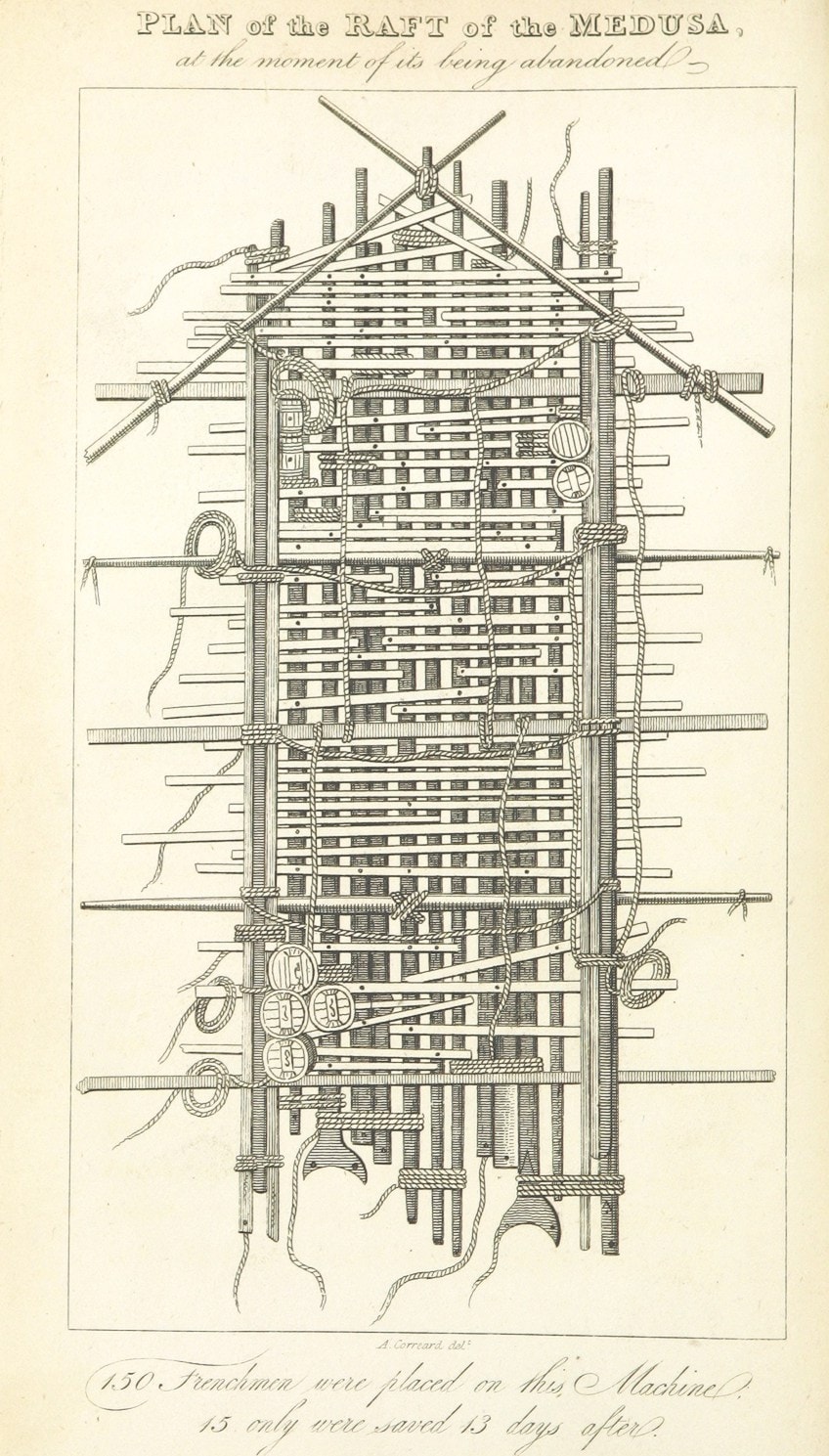 A programme of the Raft of the Medusa at the moment of its being abased (1816) by Alexandre Corréard;The British Library, No restrictions, via Wikimedia Commons
A programme of the Raft of the Medusa at the moment of its being abased (1816) by Alexandre Corréard;The British Library, No restrictions, via Wikimedia Commons
A minimum of 146 men and one adult female were crammed aboard a hurriedly constructed raft, which was partly submerged in one case loaded. 17 coiffure members chose to remain on board the stranded Méduse. The captains and crews on the other vessels intended to pull the raft, but afterwards only a few kilometers, the raft was abased. The raft's crew had simply a bag of ship'southward biscuit (devoured on the very start day), ii barrels of water (dropped overboard during boxing), and six casks of alcohol.
The gunkhole took the survivors "across the limits of human experience".
Crazed, dehydrated, and hungry, they massacred mutineers, ate their expressionless colleagues, and slaughtered the weakest. After 13 days, on the 17th of July 1816, the raft was retrieved by happenstance past the Argus – no special search attempt was undertaken for the raft by the French. Simply xv men were live at this point; the others having been slain or tossed overboard by their companions, died of famine, or thrown themselves into the water in hopelessness. The episode caused great public humiliation for the French monarchy, which had only recently been returned to power following Napoleon's defeat in 1815.
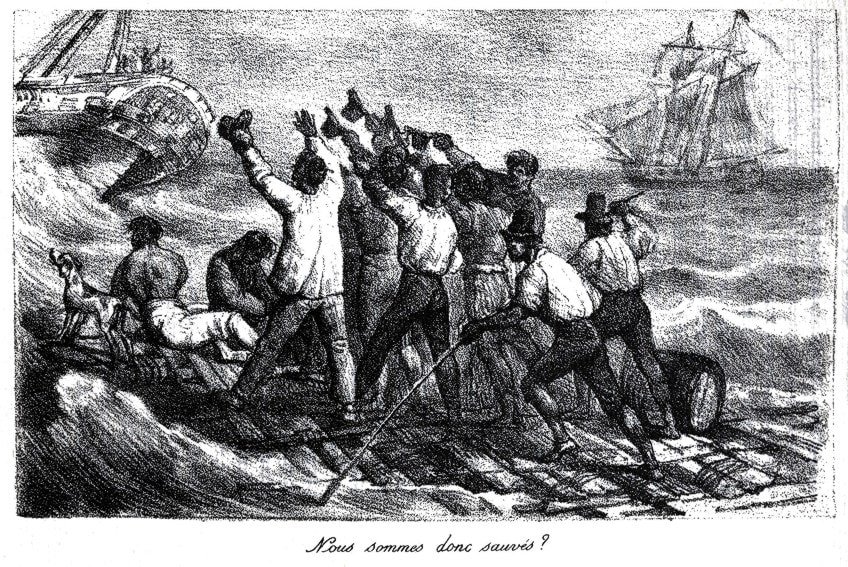 Rescuing of the survivors of Méduse, 1816. The text reads, "Are there any survivors?"; Unknown writer Unknown author, Public domain, via Wikimedia Commons
Rescuing of the survivors of Méduse, 1816. The text reads, "Are there any survivors?"; Unknown writer Unknown author, Public domain, via Wikimedia Commons
Clarification
The Raft of the Medusa past Théodore Géricault depicts the exact moment when the surviving 15 concluding survivors, post-obit thirteen days of beingness lost afloat the ocean on the raft, see a ship arriving on the horizon. The piece is set at a point when "the devastation of the raft may be regarded to be finished," co-ordinate to a British critic. The artwork is a awe-inspiring size of 491 cm by 716 cm, so the majority of the characters are life-sized, and those in the front are nearly twice life-size, pressed close to the image airplane and pushing upon the observer, who is brought into the physical action every bit a participant.
The improvised raft is depicted as scarcely seaworthy equally it rides the heavy waves, while the men are depicted as shattered and despondent. Some other old guy pulls his hair out in despair and defeat every bit he clutches his son'south torso at his knees. A smattering of bodies litters the foreground, ready to be washed away by the raging waves. The men in the heart accept but seen a lifeboat; one points it out to another, and an African member of the crew, Jean Charles, stands atop a barrel and furiously waves his scarf in an endeavour to attract the ship'south notice.
The painting'due south graphic organization is congenital around 2 pyramids. The first is formed by the perimeter of the huge mast on the canvas's left side. The front horizontal drove of dead and injured persons serves as the foundation from which the survivors emerge, rising upward into the emotional apex, where the focal figure urgently waves at a rescue craft.
The viewer'due south gaze is pulled to the center of the painting, then to the directional move of the survivors' bodies, seen from behind and stretching to the correct.
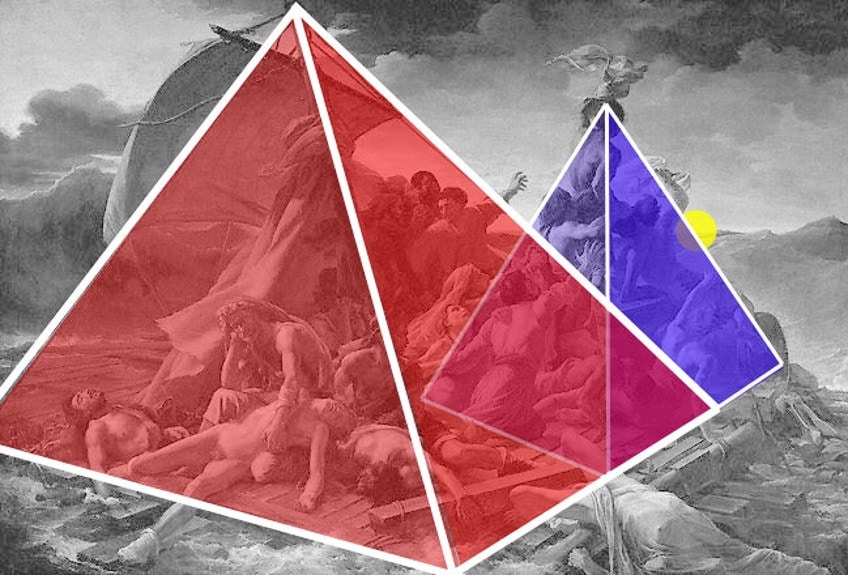 Diagram showing the outline of the ii pyramidal structures that form the basis of Théodore Géricault's The Raft of the Medusa (1819). The position of the Argus rescue vessel is indicated by the yellowish dot; Tyrenius at the English Wikipedia, CC By-SA 3.0, via Wikimedia Commons
Diagram showing the outline of the ii pyramidal structures that form the basis of Théodore Géricault's The Raft of the Medusa (1819). The position of the Argus rescue vessel is indicated by the yellowish dot; Tyrenius at the English Wikipedia, CC By-SA 3.0, via Wikimedia Commons
From the deceased at the lower left to the living at the summit, we are led past a single horizontal diagonal beat. Two more diagonal lines are employed to increase the tension and drama. The first traces the mast and its scaffolding and directs the viewer'due south gaze to an incoming wave that promises to swallow the raft, while the 2nd, formed of reaching figures, directs the viewer's gaze to the faraway outline of the Argus, the ship that finally saved the survivors.
Géricault's palette consists of frail flesh tones equally well every bit the muddy colors of the survivors' vesture, the water, and the clouds. Generally, the painting is gloomy and focuses heavily on the use of dismal, predominantly brownish hues, which Géricault thought was successful in portraying tragedy and desperation.
 The primary color palette of Théodore Géricault'southward The Raft of the Medusa (1819);Louvre Museum , CC By-SA three.0, via Wikimedia Commons
The primary color palette of Théodore Géricault'southward The Raft of the Medusa (1819);Louvre Museum , CC By-SA three.0, via Wikimedia Commons
The lighting of the piece has been characterized equally "Caravaggesque," after the Italian painter who was intimately identified with tenebrism—the apply of extreme juxtaposition between light and shade.
Even Géricault's portrayal of the water is subdued, with darker greenish hues used instead of the darker blueish tones that could have provided a juxtaposition with the tones of the raft and its people. A bright light emanates from the far region of the rescue arts and crafts, illuminating an otherwise night chocolate-brown terrain.
Execution
Géricault was attracted past reports of the well-publicized 1816 shipwreck and realized that depicting the incident may help him build his career as a painter. After deciding to keep, he conducted a meaning study before beginning the painting. He encountered two survivors in early on 1818: Henri Savigny, and Alexandre Corréard at the École nationale supérieure d'arts et métiers.
The atmosphere of the final motion-picture show was heavily influenced by their emotive recollections of their experiences.
Georges-Antoine Borias, an art historian, claims that "Géricault set up his studio beyond the street from the Beaujon hospital. And and then started a somber reject. He poured himself into his task behind closed doors. Aught frightened him. He was both feared and shunned." Géricault'south previous trips had introduced him to sufferers of madness and disease, and when studying the Méduse, his desire to exist historically exact and genuine led to a fixation with corpse rigidity.
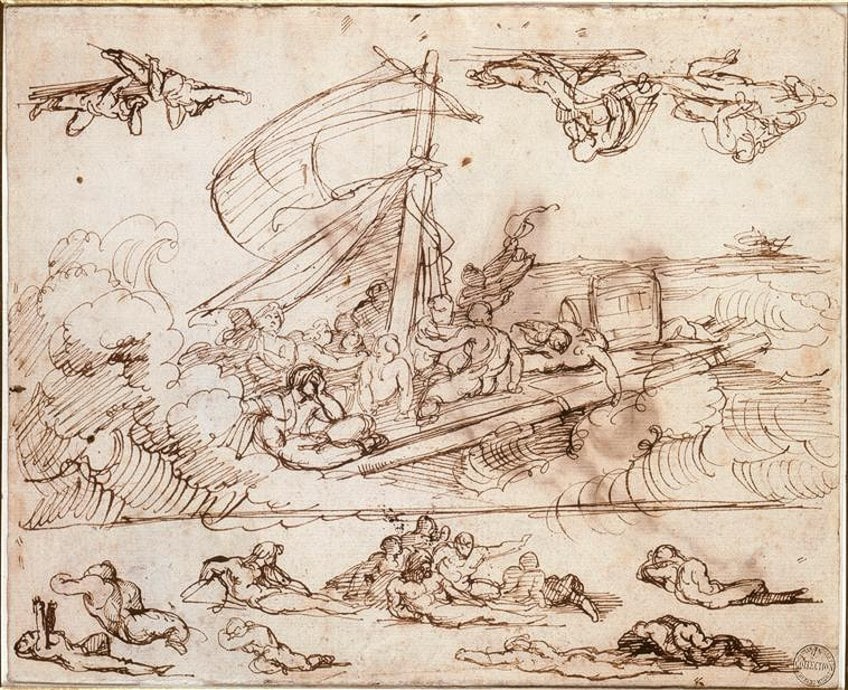 The appearance of the Argus with trunk studies (report for the Medusa) past Théodore Géricault;Théodore Géricault, Public domain, via Wikimedia Eatables
The appearance of the Argus with trunk studies (report for the Medusa) past Théodore Géricault;Théodore Géricault, Public domain, via Wikimedia Eatables
To accomplish the near accurate rendition of the skin tones of the deceased, he sketched bodies in the Infirmary Beaujon mortuary, analyzed the human confront of dying patients, decided to bring dismembered appendages back to his workshop to study their deterioration, and concluded up drawing a decapitated caput loaned from a mental asylum and saved on his workshop ceiling for a couple of weeks.
He collaborated with Corréard, Savigny, likewise as another victim, craftsman Lavallette, to create an accurate scale replica of the boat, which was recreated on the completed painting, even displaying the gaps between some of the boards. Géricault posed models, gathered research, copied important works by other painters, and traveled to Le Havre to study the water and heaven.
 The Severed Heads (1810s) by Théodore Géricault; Théodore Géricault, CC Past-SA iv.0, via Wikimedia Eatables
The Severed Heads (1810s) by Théodore Géricault; Théodore Géricault, CC Past-SA iv.0, via Wikimedia Eatables
Despite having a fever, he went to the seaside several times to sentry storms break on the coastline, and a trip to painters in England provided another chance to study the environment while traversing the English Channel. He created and painted various preliminary sketches while determining which of several different catastrophic scenes to stand for in the terminal painting.
Géricault'southward creation of the painting was slow and laborious, and he battled to cull a single graphical successful moment to best convey the intrinsic intensity of the upshot.
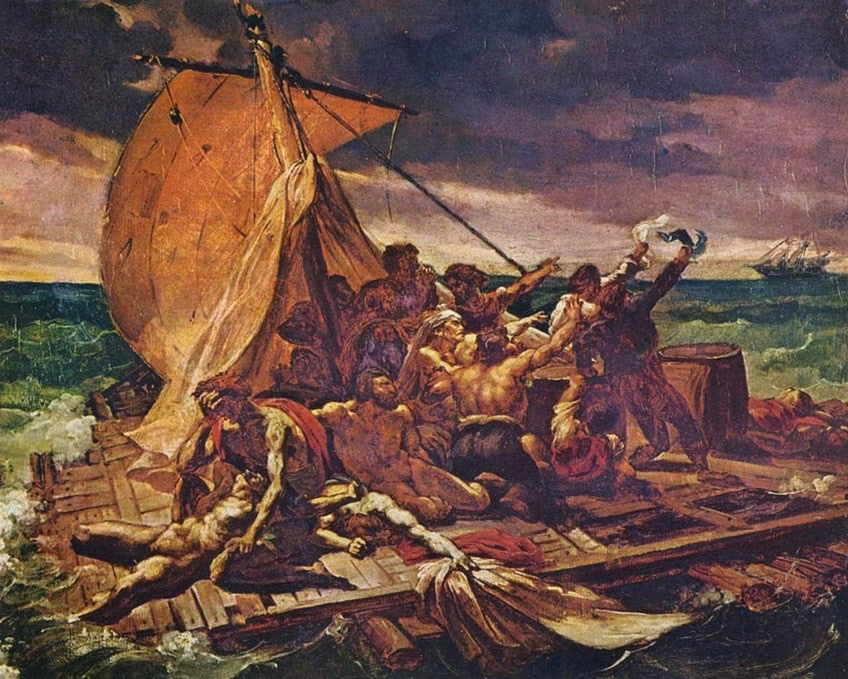 Written report for The Raft of the Medusa (1818) by Théodore Géricault;Théodore Géricault, Public domain, via Wikimedia Commons
Written report for The Raft of the Medusa (1818) by Théodore Géricault;Théodore Géricault, Public domain, via Wikimedia Commons
Among the situations he studied were the soldiers' rebellion on the second 24-hour interval on the raft, cannibalism but afterwards a few days, and the evacuation. Géricault eventually settled on the scene described past one of the victims, when they get-go noticed, on the skyline, the coming rescue ship Argus – shown in the pinnacle right of the picture – to which they sought to point. The ship, on the other hand, went by.
"From the intoxication of delight, we plummeted into tremendous sorrow and despair," one of the surviving crew members said.
Exhibition and Reception of the Raft of Medusa Painting
The Raft of Medusa painting was initially presented at the 1819 Paris Salon under the title Shipwreck Scene, despite the fact that its truthful topic would have been obvious to modern visitors. Louis Xviii funded the show, which included almost 1,300 paintings, 208 sculptures, and several more engravings and architectural drawings.
The exhibition'southward headliner was Géricault's painting, which "strikes and captures all eyes." "Monsieur Géricault, you've portrayed a catastrophe, but it'southward not 1 for you," Louis XVIII had stated three days before the opening.
 In 1820, Géricault successfully exhibited the painting in the Egyptian Hall in Piccadilly, London; Public Domain, Link
In 1820, Géricault successfully exhibited the painting in the Egyptian Hall in Piccadilly, London; Public Domain, Link
Géricault had purposely intended to be both socially and aesthetically antagonistic. Critics reacted to his stiff mental attitude in kind, with either repulsion or acclaim, depending on whether the writer sympathized with the Bourbon or Liberal position. The artwork was widely regarded as being supportive to the people stranded on the raft, and hence to the anti-imperial cause championed by the surviving Corréard and Savigny.
The inclusion of a black person at the composition's noon was a contentious representation of Géricault's abolitionist views. Christine Riding, an fine art critic, believed that the artwork's later display in London was timed to correspond with anti-slavery protests in the city.
Géricault's picture, according to fine art historian and curator Karen Wilkin, is a "jaded condemnation of the blundering misconduct of France's post-Napoleonic politicians and officials, most of which was drawn from the remaining families of the Ancient Régime." The artwork mainly attracted viewers, even so its discipline matter repulsed many, depriving Géricault of the popular success he had hoped for.
 Nicolas Sebastien Maillot's 'Raft of the Medusa' shown in Salon Carré of the Louvre, 1831, Louvre, showing Géricault's Raft hanging aslope works by Poussin, Lorrain, Rembrandt and Caravaggio; Nicolas Sébastien Maillot, Public domain, via Wikimedia Commons
Nicolas Sebastien Maillot's 'Raft of the Medusa' shown in Salon Carré of the Louvre, 1831, Louvre, showing Géricault's Raft hanging aslope works by Poussin, Lorrain, Rembrandt and Caravaggio; Nicolas Sébastien Maillot, Public domain, via Wikimedia Commons
The artwork was given a gilded medal by the panel of judges at the stop of the show, just information technology did non receive the higher honour of being selected for the Louvre'due south national inventory. The Raft of the Medusa past Théodore Géricault was advocated by the Louvre'south curator, Comte de Forbin, who acquired it from Géricault'due south heirs post-obit his death in 1824. The artwork has now taken over the gallery in which it is shown. According to the display description, "the sole hero in this moving narrative is flesh."
That concludes our await at "The Raft of the Medusa" by Théodore Géricault. Currently located at the Louvre Museum, this painting is regarded as a seminal work of French Romanticism. The incident created international controversy, in part because the blame was mostly ascribed to the French captain's inexperience.
Oft Asked Questions
Which Artist Painted the Raft of the Medusa?
Théodore Géricault'due south short career had a considerable touch on on contemporary art evolution, notably the expansion of French 19th-century painting. His revolutionary use of contemporary subjects, his blending of classical elements with a moody, painterly aesthetic, his love of equines, his interest in sublime and horrifying subjects, and his sympathy for society'southward weak and helpless make him a particularly complicated artist, but i who helped pave the way for Romanticism's emphasis on sentimentality and subjective experience. His most famous work, The Raft of Medusa, was a watershed moment in the history of modern art because it united the immediacy of electric current events and a direct sense with the traditional, huge framework of a cracking Salon painting.
What Was the Raft of Medusa Painting Nearly?
The Raft of Medusa painting represents a situation that transpired when the French naval vessel Medusa was destroyed when it went ashore off the coastline of Mauritania on July 2, 1816. After the occurrence, at least 147 individuals were left stranded on a hastily congenital raft; all simply 15 perished in the 13 days it took to discover them, and those who did survive endured starvation, extreme dehydration, and cannibalism.
Source: https://artincontext.org/the-raft-of-the-medusa-theodore-gericault/
0 Response to "Create Your Own Art Critique for the Raft of the Medusa"
Post a Comment